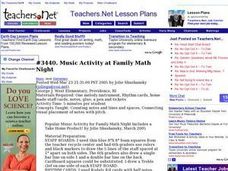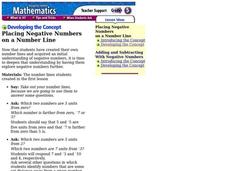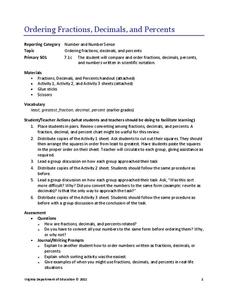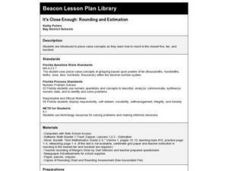Curated OER
We're in the Money
Students study money and its place in the economy. In this middle school Consumer Math lesson, students explore the barter system and the need for money. Students explore how money works in society and explore modern money...
Curated OER
Using Patterns
For this math worksheet, young scholars examine a drawing of a neighborhood made of geometric shapes. Students answer 5 questions about patterns they discover. Then young scholars answer 5 word questions about address numbers by using...
Curated OER
Pizza Fractions
Everyone loves pizza! Learners define fractions and use manipulatives to calculate fractions. Kids cut circles to represent various fractional parts of a pizza. Some accommodations are included.
Federal Reserve Bank
Creditors’ Criteria and Borrowers’ Rights and Responsibilities
Discover what criteria creditors use for making loans (the 3 Cs of Credit), and impress upon your young adults the rights and responsibilities related to using credit. Pupils role play as individuals seeking or providing credit, as...
NASA
Food For Thought
Science can be quite tasty. A delectable unit from NASA shows learners why it's important to consider food, nutrition, and health in space. Four lessons explore the idea in great depth, including testing cookie recipes. Along the way,...
Curated OER
Places and Production
Learners investigate the economy and the market value of goods. In this algebra lesson plan, students differentiate between domestic goods value and international good value. The define and identify the importance of GDP or Gross...
Curated OER
Music Activity at Family Math Night
Learners work with a family member in placing all of the music notes on a staff board. They try to match the rhythm on the rhythm board and show their completed song to the teacher.
Curated OER
Placing Negative Numbers on a Number Line
Students plot numbers on a number line. In this negative numbers instructional activity, students create their own number line. Students discuss the concept of negative numbers and plot some on their number lines. Students create true...
Virginia Department of Education
Ordering Fractions, Decimals, and Percents
Order up a resource on comparing rational numbers. Scholars order fractions, decimals, and percents by converting to a single form. They conduct a cut-and-paste activity ordering three sets of rational numbers.
Curated OER
100 Dots
In this counting skills worksheet, students draw 10 dots on each of the 10 pictured ladybugs.
Curated OER
Subtracting Mixed Numbers
In this math worksheet, students subtract mixed numbers. Students find common denominators. They subtract the fractions and whole numbers.
Curated OER
Percents: What's the Use?
Students explore percentages in real world situations. In this percents activity, students determine the final sales price after discounts. Students interview community members and determine how percentages are used in the real world.
Curated OER
Math: Something's Fishy
Fifth graders imagine an aquarium filled with 1,000 fish on a math worksheet. They express each species as a fraction of the total number of fish in the tank. Students reduce each fraction to lowest terms and then express them as...
Curated OER
The Hot Dog Stand: Combinations
In this combination worksheet, students rearrange integers to determine the number of combinations that can be made from given numbers. This one-page worksheet contains one combination problem.
Curated OER
Tens and Ones
Learners view three problems involving adding or subtracting with ones and tens. Each problem is followed by an explanation and an answer as to how the problem should be done. Note: This resource contains incorrect grammar and could be...
EngageNY
Applying Tangents
What does geometry have to do with depression? It's an angle of course! Learners apply the tangent ratio to problem solving questions by finding missing lengths. Problems include angles of elevation and angles of depression. Pupils make...
EngageNY
The Distributive Property and the Products of Decimals
Make multiplication of decimals easier by applying the distributive property. Pupils investigate how they can use the distributive property to multiply decimals. After learning the strategy, they work on some practice problems at...
Curated OER
Y-Intercept and Slope Intercept Form
Alegebra amateurs identify the slope and the y-intercept given a linear equation in slope-intercept form by correctly completing some in class problems. They write the linear equation in slope-intercept form that corresponds to the given...
Illustrative Mathematics
Mile High
What is the meaning of sea level? This resource helps your class understand the meaning of elevations above, below, and at sea level. Provides for good discussion on using positive and negative numbers to represent quantities in the real...
Willow Tree
Simple Probability
The probability of learning from this lesson is high! Learners calculate probabilities as numbers and as decimals. They see how to use a complement to find a probability and even try a simple geometric probability problem.
Curated OER
What Can Data Tell Us?
Students analyze data they have collected themselves and by their classmates. In groups, they create data distributions to identify the highest, lowest and middle values. As a class, they discuss the concept of sample size and how it can...
Curated OER
Comparing and Ordering Greater Numbers
Students compare and order greater numbers. In this place value lesson plan, students use a place-value chart to identify which set of numbers has the greatest value.
Curated OER
Money: Demonstrating Coin Value up to $1.00
Students examine coin values up to $1.00 using paper coins. In this coin value lesson, students compare and contrast various coins to aid in identification, sort coins from smallest to largest, and match an equal number of pennies to...
Curated OER
It's Close Enough: Rounding and Estimation
Second graders round to the closest five, ten, and hundred. They use place-value concepts of grouping based upon powers of ten (thousandths, hundredths, tenths, ones, tens, hundreds, thousands) within the decimal number system.

























